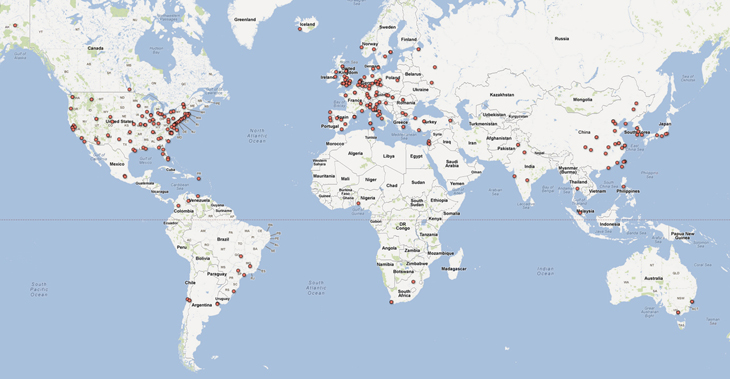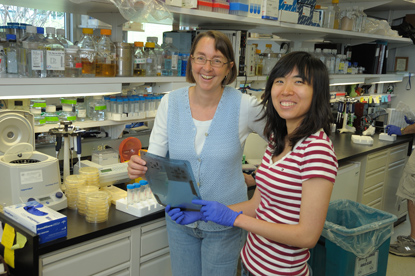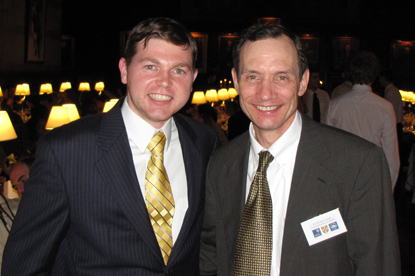Grad Students Unite
The NIH Graduate Partnerships Program
On the road to doing independent scientific research, graduate school is a rite of passage. And so is the NIH—at least for the students who choose to do their dissertation work there. Their Ph.D. still comes from an academic institution, but it’s based on research done in an NIH intramural laboratory. This setup is all part of the Graduate Partnerships Program (GPP).
“GPP offer[s] depth and breadth in research topics, world-class resources in and outside the lab, and leading scientists [who are] happy to collaborate and contribute to your training,” said Kimberly Decker, who got her Ph.D. in molecular biology from Johns Hopkins University (Baltimore) in 2011 and did her research at the National Institute of Diabetes and Digestive and Kidney Diseases. She’s now a postdoctoral fellow at the Eunice Kennedy Shriver National Institute of Child Health and Human Development.

BILL BRANSON
Graduate student Xuefeng Yin (right), who is getting her Ph.D. in microbiology from Peking University in China, is doing her dissertation research in the lab of NICHD senior investigator Gisela Storz (left).
“The NIH is a unique place to get a Ph.D.,” said Augustin Luna, who is getting a Ph.D. in bioinformatics from Boston University (Boston) and working in Mirit Aladjem’s lab at the National Cancer Institute (NCI). “Since there are primarily postdocs here, what is expected of a student . . . is higher than in other places. [And] there is always acknowledgement and credit for work done.”
The GPP typically attracts students who are interested in translational or clinical research. They often provide an intellectual spark in the lab, bringing new ideas and questions that a principal investigator may not otherwise consider. They are “very independent, mature, highly motivated, and productive,” said Deputy Director for Intramural Research (DDIR) Michael Gottesman, who has hosted four GPP students in his lab. “These students become the catalysts for collaboration [among] investigators.”
Working with graduate students can help principal investigators hone their mentoring skills, too. Mentoring graduate students “can be one of the most rewarding and intellectually satisfying experiences a PI can have,” said Office of Intramural Training and Research (OITE) Director Sharon Milgram. “Support from ICs, partnership directors, and administrative staff has made [the GPP] a really positive force on campus.”
A History of the GPP
Graduate students have been coming to NIH to work with its intramural scientists since the 1960s. NIH has never granted degrees itself, but in addition to encouraging students to work with its researchers, it has a long history of providing educational programs. In 1959, the Foundation for Advanced Education in the Sciences (FAES) was established as a nonprofit to promote scientific education and support biomedical research within the NIH intramural program. Each year, FAES offers nearly 200 graduate- and undergraduate-level courses that are accepted for credit at many universities. It also runs a bookstore, a music series, and an insurance program.
In the 1970s, NIH considered starting its own graduate school, but many investigators were concerned that the lack of infrastructure and experience would make it difficult to run a successful program. In the 1990s, then–NIH director Harold Varmus resurrected the idea of establishing a formal degree-granting program, but the Advisory Committee to the Director recommended against it. So Varmus and DDIR Gottesman proposed that NIH establish partnerships with universities whereby students could do their thesis work at NIH and earn their degree from an academic institution. In July 2000, the NIH GPP was launched to formally link the NIH intramural program with universities in the training of graduate students in the biomedical sciences. (See Gottesman’s essay on page 2 for more on the GPP history.)
The GPP Today
Today, the NIH GPP offers structured and cohesive training experiences to expand opportunities for Ph.D. candidates both at and away from the bench while enriching the intramural program by giving faculty and postdoctoral fellows the opportunity to teach. Currently, there are about 500 graduate students from more than 100 domestic and international universities who are doing research at NIH campuses in nearly every institute and center (IC).
Students can enter the GPP through two mechanisms: institutional partnerships and individual partnerships. Institutional partnerships are established programs between the NIH and universities through which prospective students apply to begin their graduate education in the GPP. There are numerous institutional partnerships administered by the OITE and various NIH ICs. For individual partnerships, currently enrolled Ph.D. students (from domestic and international universities) establish agreements between their universities and NIH intramural investigators.
Compared with most graduate programs at universities, the NIH GPP offers a larger research environment and is spread across the 24 ICs that do intramural research. In addition, GPP students can participate in courses offered by FAES and OITE; attend workshops and activities held by their ICs; and participate in the Graduate Student Seminar Series in which they present their research to their peers and postdocs who provide critical feedback. Students also attend an annual GPP-sponsored retreat that is replete with science and professional- and career-development workshops. In January, students participate in the Graduate Student Research Symposium in which they showcase their research to the NIH community, listen to speakers, and attend the annual GPP graduation and awards ceremonies.
There are plenty of opportunities for non-science activities, too. Students can practice their leadership skills by participating in the Graduate Student Council (GSC). The GSC’s Volunteer Committee organizes community service projects ranging from cooking dinner at the NIH Children’s Inn to tutoring local children in a D.C. transitional housing program. The GSC also organizes social events and other activities and coordinates an after-hours seminar series.
On the following pages we highlight three graduate students and their NIH mentors. Some of the interviewers are GPP students themselves. Katherine Bricceno (Gisela Storz and Xuefeng Yin) and Alexis Boyd (Mirit I. Aladjem and Augustin Luna, who also provided the map for the online version of this article) are both graduate students at George Washington University (Washington, D.C.). Bricceno is getting a Ph.D. in biochemistry and molecular genetics and doing her research at NINDS. Boyd is getting a Ph.D. in immunoparasitology and doing her research at NIAID. Monika Deshpande (Michael Lenardo and Austin Swafford) is a postdoctoral fellow in NCI. Meghan Mott, is a postdoctoral fellow in NIAAA.
For more information on the GPP, including a complete list of institutional programs and instructions on establishing individual partnerships, go to https://www.training.nih.gov/programs/gpp. For more information on FAES, go to https://www.faes.org/.
BELOW: Graduate students come to NIH from universities around the world. The red circles denote the locations of universities that have graduate students conducting thesis research at NIH.

AUGUSTIN LUNA, NCI
NIH Scientist Gisela Storz and Graduate Student Xuefeng Yin

ERNIE BRANSON
Gisela Storz (left) and graduate student Xuefeng Yin (right)
The scientist: Gisela Storz, Ph.D. (left)
Title: Senior investigator and deputy director, Cell Biology and Metabolism Program
Institute: NICHD
Came to NIH: In 1989 for training in NCI; returned in 1991
What qualities do you look for in a graduate student for your lab?
I look for students who are enthusiastic and take initiative because having a student with these qualities makes the research more fun.
What are the benefits—and challenges—of having graduate students in the lab?
Grad students are a pleasure to have in the lab; they are less jaded because they are at an earlier stage in their careers. Keeping track of university requirements can be challenging.
What is your strategy for mentoring?
My approach is the same for everyone. Students start working with others and then give more input on a project. As they sprout wings, I encourage them to be more independent.
How is mentoring rewarding and difficult?
It’s rewarding to see people succeed. I didn’t anticipate how much I would enjoy mentoring. The most difficult is learning how best to interact with each individual.
What advice do you have for those who want to improve their mentoring skills?
Be up front about expectations. It is also good to know what students want. It is easier to work together toward a common goal.
How can grad students get the most out of their relationships with their mentors?
Be enthusiastic and take initiative. I like students who read papers, come up with new ideas, and are thinking about the project.
The graduate student: Xuefeng Yin (right)
Hometown: Beijing, China
Education: B.S. in medicine, Peking University (Beijing)
Earning Ph.D.: In molecular biology from Peking University
What are your career goals?
I enjoy research—and the passion and enthusiasm that go into it—in an academic setting. I am also exploring other options and am considering doing postdoctoral fellowships in academia and industry.
What made you decide to do your graduate research at NIH?
I knew about the NIH’s reputation for prestigious research and learned about the Graduate Partnerships Program from a professor.
What makes Dr. Storz a good mentor?
She enjoys mentoring and is very supportive of my transition from medicine to microbiology and to a new culture.
What got you interested in science?
While working in a lab as an undergraduate, I had my own project and became interested in how the cell works. I wanted to pursue further research in basic science.
What are the most exciting and challenging aspects of research?
It’s rewarding to learn something new. It’s challenging when my experiments aren’t working and I can’t get data.
What are your non-work interests?
I like to socialize with lab members outside of work. We played paintball, went to the Cherry Blossom Festival, and tried to go a Nationals game but it was rained out.
The laboratory: Xuefeng Yin and Maureen Thomason (from Georgetown University in Washington, D.C.) are the lab’s first two graduate students. Storz’s group made the serendipitous discovery of one of the first small, regulatory RNAs to be identified. Her lab works on the genome-wide identification and characterization of small RNAs in bacteria. Yin is studying two small membrane proteins that are thought to regulate transport and efflux pumps in the cell membrane.
NIH Scientist Mirit I. Aladjem and Graduate Student Augustin Luna

SOHYOUNG KIM, NCI
Mirit I. Aladjem (right) and graduate student Augustin Luna(left)
The scientist: Mirit I. Aladjem, Ph.D. (right)
Title: Senior investigator, Laboratory of Molecular Pharmacology
Institute: NCI
Came to NIH: In 1999
What qualities do you look for in graduate students for your lab?
The ability to understand an experiment; the intellect to follow a scientific question; open-mindedness about research; being independent and resourceful; and having a drive that comes from within.
What is your strategy for mentoring?
I encourage students to ask questions, make their own decisions, and interact with collaborators and other researchers by presenting at meetings and seminars.
What is rewarding—and difficult—about mentoring?
It’s difficult, yet rewarding, to bring people to the point of being independent and able to think for themselves.
How can graduate students get the most out of relationships with their mentors?
Ask questions and listen. Try to understand how your mentor makes decisions. Mentors can teach about life in science in general and not just about specific research. Participate in the lab fully. Interact positively with colleagues so they will be willing to help you.
How have mentors helped you?
Three mentors served as role models and showed me how to balance my professional and personal life. I also learned how to manage a lab and how to approach the challenges of science.
The graduate student: Augustin Luna (left)
Hometown: Maysville, Ga.
Education: B.S. in biomedical engineering, Georgia Institute of Technology (Atlanta)
Earning Ph.D.: In bioinformatics from Boston University (Boston)
What are your career goals?
To find a position—in academia or perhaps industry—that merges mathematical modeling, pharmacodynamics, pharmacogenomics, and pathway analysis.
How did you select the lab you’re in?
I wanted to do mathematical modeling so searched for labs doing work in bioinformatics, cancer, and aging. Mirit had received a postbac mentor award so I knew she would be a good mentor.
What makes Dr. Aladjem a good mentor?
She is very open to collaboration. She knows who can help me on technical computational issues and encourages me to talk to them and to go to conferences to meet others in the field. She also has the truest open-door policy of anyone I have ever worked for.
What got you interested in science?
When I was a child, my father had an accident in which he severed three fingers. Two were reattached, but never regained full mobility. That drove me to ask why; I wanted to advance knowledge in that area. As an undergrad, I took courses in cell and tissue engineering, which helped me appreciate that the lack of understanding of biological networks was a major problem in medicine.
What are the most exciting and challenging aspects of your research?
Figuring out how to integrate information—and contradictory findings—obtained from bioinformatics approaches to research.
What are your interests outside of work?
I enjoy art; I recently had an exhibit entitled “Random Walks” at Artomatic in Crystal City (Arlington, Va.). I also do volunteer work through NIH’s Graduate Student Council and tutor minority students.
The laboratory: Augustin Luna is the lab’s first graduate student. Aladjem studies the molecular regulation of cell growth, and her lab is part of a consortium made up of NIH researchers who are creating tools to describe protein interactions. Luna is collaborating with a co-mentor, Kurt Kohn, to develop a computer software program that will visualize signaling pathways and is developing a mathematical model to connect circadian rhythms to DNA repair responses.
NIH Scientist Michael J. Lenardo and Graduate Student Austin Swafford

MATT VOGT, NIAID
Michael J. Lenardo (right) and graduate student Austin Swafford (left)
The scientist: Michael J. Lenardo, M.D. (right)
Title: Senior investigator; chief, Molecular Development of the Immune System Section, Laboratory of Immunology
Institute: NIAID
Came to NIH: In 1989
What qualities do you look for in graduate students for your lab?
I interview students in person. Often the students who get shortlisted are enthusiastic, open-minded, and smart.
What are the benefits—and challenges—of having graduate students in your lab?
Graduate students bring energy and enthusiasm. They are curious and open to taking on risky projects. The biggest challenge is finding money to pay them.
What is your strategy for mentoring?
I tailor toward individual needs. I encourage independent thinking, data-driven hypotheses, and getting input from everyone.
How is mentoring rewarding and difficult?
It’s rewarding to watch the students grow and become independent thinkers. Training students is fun.
How can graduate students get the most out of relationships with mentors?
Work very hard. Take advantage of the resources available to you, have open lines of communications between your mentor and others in the lab, and learn a lot.
The graduate student: Austin Swafford (left)
Hometown: New Orleans
Education: B.S. in molecular biology, University of Texas at Dallas
Earning Ph.D.: In medical genetics and immunology from the University of Cambridge (England)
What are your career goals?
I have a passion for performing translational research and would like to develop a lab at a medical school or research hospital. I am particularly interested in engineering-targeted therapeutic agents.
What got you interested in science?
I was diagnosed with type 1 diabetes at age 8. Learning how to manage my disease was my first introduction to the complexities of biological systems. I wanted to understand biology so I could use it to improve the health and lives of others.
What made you decide to do your graduate research at NIH?
I was attracted by the flexibility and autonomy that would enable me to design my Ph.D. project. I was enthusiastic about the prospect of harnessing the experience and expertise from multiple sources.
How did you select the lab you’re in?
Through a mixture of serendipity and seized opportunity. I scheduled a meeting with Dr. Lenardo because he was developing immunomodulatory therapeutics to prevent type 1 diabetes. The interview turned into a fantastic brainstorming session, and I fell in love with the project we laid out.
What are the most exciting—and challenging—aspects of the research process?
It’s exciting to realize you may be doing something that no one has ever done before to gain insight into a phenomenon. It can be challenging to see the connection between the pipette and the patient.
What are your interests outside of work?
I enjoy playing Frisbee, soccer, and board games. I have been teaching myself the basics of Hebrew, Chinese, and Japanese to be able to communicate with people from diverse backgrounds and cultures.
The laboratory: Lenardo’s laboratory is investigating the molecular regulation of T lymphocytes in order to develop novel means of diagnosis and immunomodulation for autoimmune diseases such as multiple sclerosis and type 1 diabetes. Lenardo has had more than a dozen graduate students in his lab. He also founded and directed two graduate partnership programs—the Oxford-Cambridge (England) program and the University of Pennsylvania (Philadelphia) immunology program. Swafford is currently examining the diversity of T cells in a mouse model of type 1 diabetes.
This page was last updated on Friday, April 29, 2022
